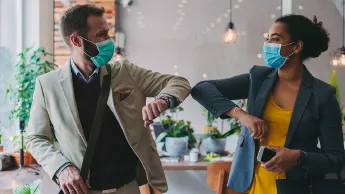The results of corona – a personal experiment in new ways of greeting
- 2020-09-14
- Guest contribution by alumna Aigul Zhalgassova
- Comment

In the first weeks of the lockdown, the news about corona was full of stories about new countries at risk and conspiracy theories. I was soon fairly jaded by all this information, but then one headline did attract my attention: "Will our greeting culture change without handshakes?" was the question. One that didn't initially appear to be all that relevant to me. Here I was firmly established in my own four walls – and anyway, given my relatively rare trips to the supermarket, I hadn't even met anyone I could have greeted. Shaking hands had disappeared from my life from one day to the next.
Relaxation of the corona restrictions changed all that – and I did then face the handshake question. I met one of my favourite female colleagues in the office corridor during an IT update. We stood indecisively opposite each other: how should we greet one another? She began by waving both hands. It looked a bit like she was trying to screw two light bulbs into the ceiling lamp, and she reminded me of how the Queen waves – only ten times faster. I had to laugh, I just couldn't think of a fitting reaction or gesture.
A plan is hatched
The next challenge I faced was during a visit to our family doctor: as he stepped into the treatment room, I jumped up and stretched out my hand to him as usual. A fairly "new normal faux pas" in the circumstances, I would say. That was when realised I needed a plan. And that we as a society also need a new ritual as an alternative to shaking hands.
The web is teeming with countless suggestions about how we can greet each other without spreading the virus. From creative TikTok videos to statements by leading politicians, there's a lot out there. Angela Merkel, for instance, recommends that instead of shaking hands we look the other person in the eye for a second longer – and smile. That's a nice alternative, which in my view has a good chance of being accepted by many.
"Less handshaking, longer eye contact" - How Angela Merkel protects herself from the corona virus
It's also interesting to read online how divided people are in their reaction to the loss of our traditional greeting ritual: some are happy to avoid any further physical contact. They won't miss other people's soft, sweaty or hot palms. A second group will miss this gesture of trust, of touching hands. Yet there is one point on which almost everyone agrees: many meetings and conversations will only take place online in future. Our society will come to rely on working from home and the greeting gesture will be performed solo. Simply put, a greeting will no longer involve human contact between two conversation partners in the foreseeable future.
My favourites for the greeting ritual
The last few weeks cost me a lot of effort. Or to put it in positive terms: flexibility. I selected a dozen from the colourful bunch of handshake alternatives and tested them in everyday life – with friends or in public offices. It was possible to achieve a lot with coordination and charm: on one occasion I bowed, then I suggested my colleagues and I greet one another by touching the insides of our feet, later I tested the fist greeting and the greeting with a bow, as practised in Asia. My father wrote encouragingly via Messenger: "Do it with your elbows. That's popular in Kazakhstan."
Here are my top three:
The corona pandemic has taught us one thing: we as a society can change – even rapidly. Millennia-old traditions have to be put on hold – at least for a while. Because viruses do not pay them any respect. So a new standard emerges almost incidentally, and one that is also cosmopolitan. What do you think – which will become the new greeting ritual?
